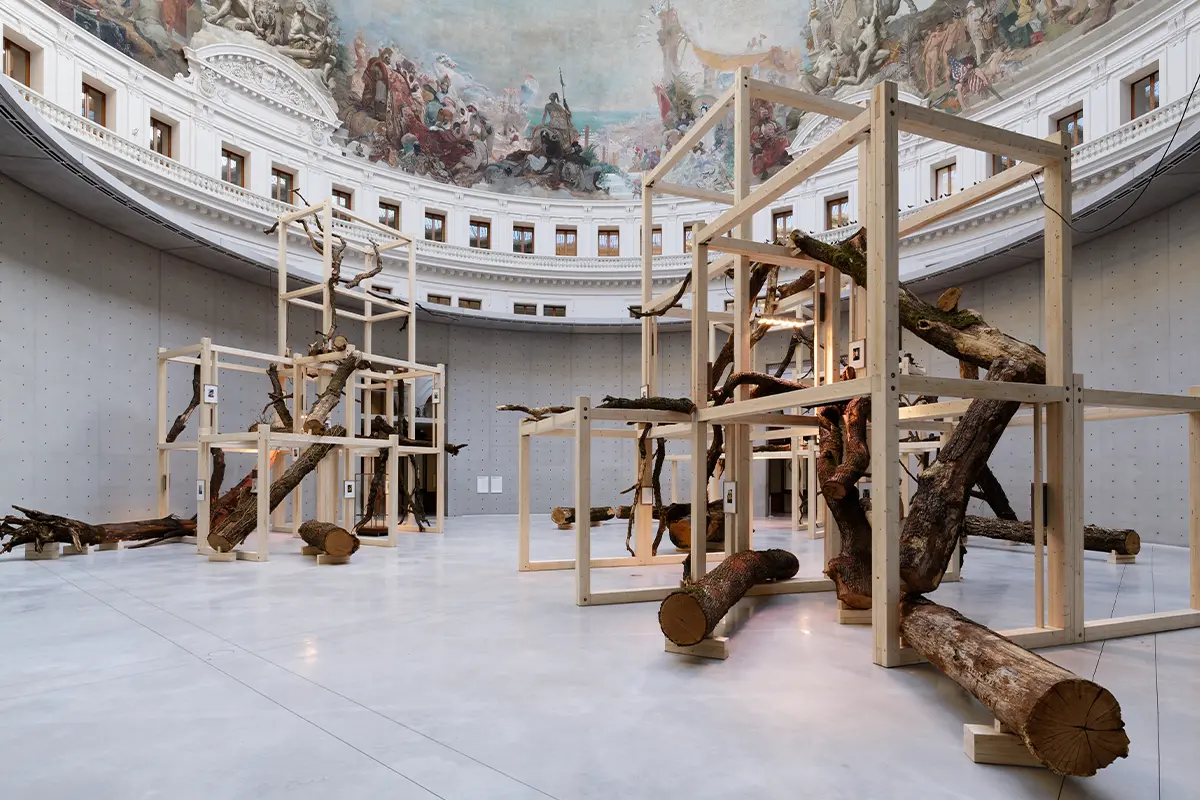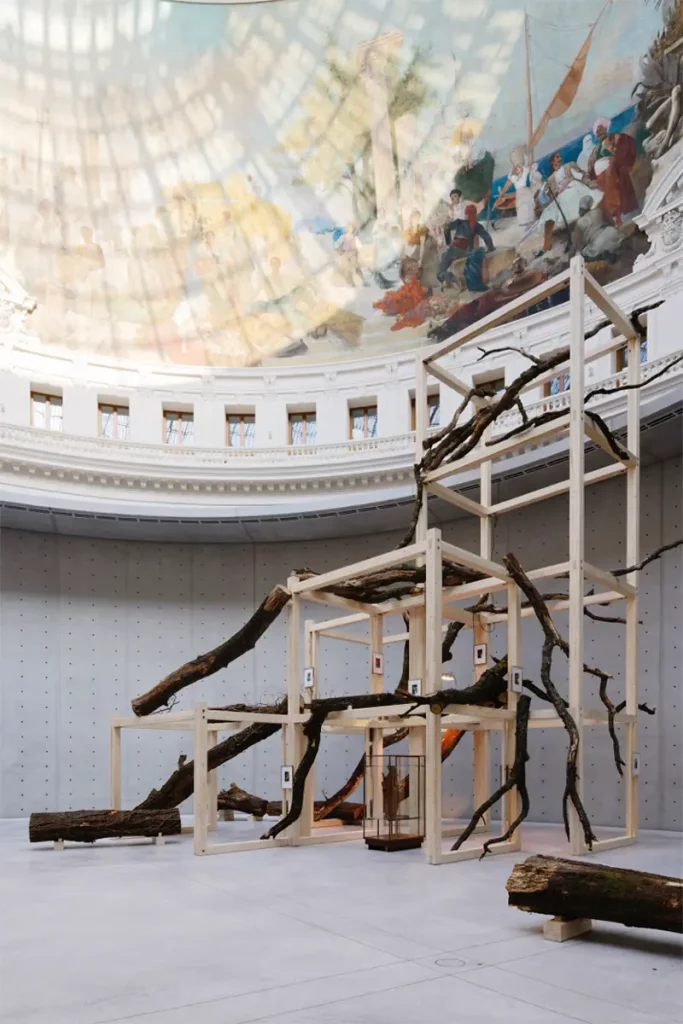Deconstructing the Western gaze: a post-naturalist aesthetic, the climate crisis – less a transformation than the visible manifestation. Before the Storm, Pinault Collection
Pinault exhibition at Bourse de Commerce: Before the Storm
July 2023, Paris. The 2023 season by the Pinault Collection at Bourse de Commerce has an interesting title: Avant L’Orage. Before the Storm. Twenty contemporary artists come together in the prestigious building to discuss and revisit human beings’ relationship with nature.
From Tacita Dean to Frank Bowling, Diana Thater, Hicham Berrada, Cy Twombly, Daniel Steegman Mangrané, Thu Van Tran and Dineo Seshee Bopape. Part of the idea is to reimagine the role of meteorology and the relationship between figurative arts and the climate. In his comment to the exhibition, philosopher Emanuele Coccia starts from the assumption that «we are the storm». Everything is connected – seeing it just requires an effort of imagination. And this is what art is for.
Nature as a social construct by Descola: Pinault deconstructs
To remain within the territory, French anthropologist Philippe Descola became famous for a bold claim: that nature is a social construct. Nature as we are accustomed to think of it, he argues, does not exist. No such thing – except from what we human beings created with our representations. The use of the concept is straightforward: to create a hierarchy. On the top is us, human beings – the knowing subjects.
Everything else – simplistically labeled as ‘nature’ for centuries – is a mere object of our knowledge. Something we can investigate, change, respect or disrespect at our choice, act upon. In any case, something mute, passive, with no full, complete interiority.
This way of thinking (and acting) is convenient to fuel our sense of omnipotence, but there is a flaw in the logic: it is only present in the contemporary West. So, Descola suggests, it might be a good time to question it. This is an ideal standpoint to reflect on the Before the Storm exhibition by Pinault Collection.
Pinault: selected artists build new imaginaries
The twenty artists showcased in Before the Storm by Pinault Collection all challenge this particular idea of naturalism. Just as figurative arts in the past centuries have helped build this passive idea of nature and non-human beings, they have the power to create new imaginaries, by activating new ways of seeing the world, engaging with the audience.
«The art of the last several years», comments curator Nicolas-Xavier Ferrand, «holds clues to the emergence of a post-naturalist aesthetic, which attempts to distance itself from the above-mentioned habitus». And referring to the Before the Storm artists: «Several of the artists in this exhibition have in fact made the deconstruction of the modern Western gaze a core component of their approach».
Thater, Berrada, Steegmann Mangrané, Tran at Pinault: sympoïesis
Some went as far as embracing the idea of creating with nature, with the world, giving up part of the agency we are accustomed to place exclusively in humans’ hands – or in the artist’s in this case. This means «acknowledging the ‘sympoïesis’, which is a word for designating the worlds that are shaped with, jointly». For instance, Chernobyl by Diana Thater is «totally informed by its place-title».
In the work, images are projected on the walls of an architectural space that evokes the abandoned theater in the town of Pripyat, close to Chernobyl. was filmed in the Exclusion Zone, a 2,200 km2 area around the nuclear reactor in which radioactivity levels are deemed to be too high. Animal life has nevertheless developed in this irremediably damaged space that has nevertheless gone back to the wild.
Berrada’s Présage is only possible because of the specific conditions of the milieu in which he places the metal, one in which a human would never be able to survive. Works by Steegmann Mangrané and Thu Van Tran look the way they do only because of the peculiarities of the space at the Bourse de Commerce.
Becoming beasts: Ferrand about Before the Storm
Embracing this way of thinking automatically destroys our modern urge to categorize separating raw facts from social ones, nature from culture. Changing perspective means questioning our place in the world. It makes your head spin: «In his Cannibal Metaphysics, » Ferrand explains, «Eduardo Viveiros de Castro emphasized to what extent the different use of perspective could yield a singular rapport to one’s existence and to others».
The showcased at Bourse de Commerce by the Pinault Collection does it: it makes a beast of the human – in the best way possible. Accepting that there might be no hierarchy at all opens up new, raw and brave possibilities to think about the world – and to change the way we act accordingly.
We are the storm: Coccia about the exhibition at Bourse de Commerce
«We are the storm and the earthquake, the tsunami and Gaia’s thunder», writes Coccia, pondering on the exhibition. The «we» he uses does not just refer to human beings, but to all living creatures. Life is the planet’s natural force – not just ours – and «the influence of life on the planet corresponds to its very form: living beings have occupied and irrevocably transformed the entire chemical and physical reality of the atmosphere, hydrosphere, and lithosphere».
Before the Storm’s post-catastrophic approach to the issue of climate change
In this context, he argues, «meteorology rather than biology or ecology is the best vantage point for understanding the living world». Everything impacts everything else. It is almost frightening, but this viewpoint offers a new way to interpret reality: «the climate crisis we are currently experiencing is less a transformation of the climate than the visible manifestation of the deeply and irrevocably irregular and indomitable character of the world to which we belong».
The meaning of Before the Storm follows exactly the same reasoning: «everything on our Earth is a natural force. And this is what the artworks in this exhibition wish to demonstrate. They all share a post-catastrophic approach to the issue of climate change: after all, we do not really know if we are before or after the storm, because the entire world has become a storm. And the storm is nothing more than the song of life».
Tacita Dean: Geography Biography created for Before the Storm
The work of British artist Tacita Dean, specifically created for Before the Storm is titled Geography Biography and is all about geological time and dystopian landscapes. The exhibition, part of the 2023 program, opened last May and occupies part of the ground floor of the Bourse de Commerce.
In the words of curator Emma Lavigne, it «invites its viewers to drift away, for the choreographed flow of time and disorientation, for the sakura, the thousand- year-old cherry trees that have for centuries adorned themselves at the close of winter with their ephemeral blossoms, and for the trembling landscapes that register and record the seismic advent of new political boundaries within the folds of their topography».
In the pieces, giants of nature express their paradoxical fragility through the obsolescence of the materials of which they are made: chalk, film, watercolor. Elements that are in the process of disappearing and about to become, a series of memento mori of the here and now that yield, before the storm, to a ‘nostalgia for the season that has just left us’, what the Japanese call nagori. Similarly to other artists in the show, «she invites chance into her work, along with the corollary notion of uncertainty».
Diana Thater: The best outside is the inside
Two video monitors show the same subject, a forest at night in different ways: one shows a fixed view, while the other shows a series of reverse shots, some of which show the film crew filming the first view. The work questions the supposed neutrality of the viewer, who in turn becomes the object of someone else’s attention. The film deconstructs our relationship to the landscape.
It no longer is the medium of our aesthetic intentions, rather an environment in which a set of relations play out, of which we are just one link. Thater work investigates different dualisms: the unresolved tensions between the natural environment and the culture of technology, between wilderness and domesticity, between scientific knowledge and magical thinking, institutions and the body, and between the exhibition as a system and the gaze.
Cy Twombly and Steegmann Mangrané: in dialogue at Pinault
Gallery six is dedicated to the dialogue between two different, celebrated contemporary artists. The series of paintings by Cy Twombly titled the Coronation of Sesostris is a digression on a Pharaoh’s mystical voyage that is as somber as it is celestial. In a changing solar cycle, the life of the Pharaoh becomes blurred with that of the God Ra.
From this metaphor, the whole series portrays an uncertain cycle in which each element seems as if it could be something else. Steegmann Mangrané arranged his works in an orbit around Twombly’s. His work seeks to convey the ‘great fragility’ of the world. His Breathing Lines, which live to the rhythm of their environment, testify to the profoundly relational nature of things; like Twombly’s sun, his works appear to metamorphose constantly. Neither nature nor culture, they are merely variations in light.
Thu Van Tran: from Vietnam, Pénétrable and Les Couleurs du gris
Les Couleurs du gris and Pénétrable are recent works by Vietnamese artist Thu Van Tran. It is based on the Vietnam War and the traces it has left in the ground and on people’s bodies. A perfect example of letting nature, the environment, the world into a work of art in co-creation. Les Couleurs du gris alludes to the colors of the dioxins used by the US military.
Their toxic slime has permanently destroyed tropical forests. Pénétrable, which was created on site in Gallery 7 of the museum, echoes the moral imprint of the site, a building that was restored in the late nineteenth century and which fed on France’s colonial and commercial exploits during its industrial revolution. Art is no longer estranged from the places it confronts and it is exhibited in – the environment in and around it has an impact.
A step back: leaving Before the Storm
When they leave Before the Storm, viewers might have a different mindset than they did before. This is what art and beauty can do. People in power have always either feared or loved art – or both. Used it or canceled it. We are left to wonder what the relationship to power of this particular exhibition is.
It is transformative in its own right. A power that is plural – just like the gazes it showcases – and stands on its own. The power comes from within – it is us: that same «us» that is the storm, the earthquake, the tsunami and Gaia’s thunder. Art is just necessary.
Pinault Collection
Pinault Collection is the legal entity holding the artistic and cultural assets of the French businessman François Pinault. It manages the art collection of the Pinault family, its exhibition sites, institutional and cultural partnerships, art loans, and artist-in-residence programs.




















